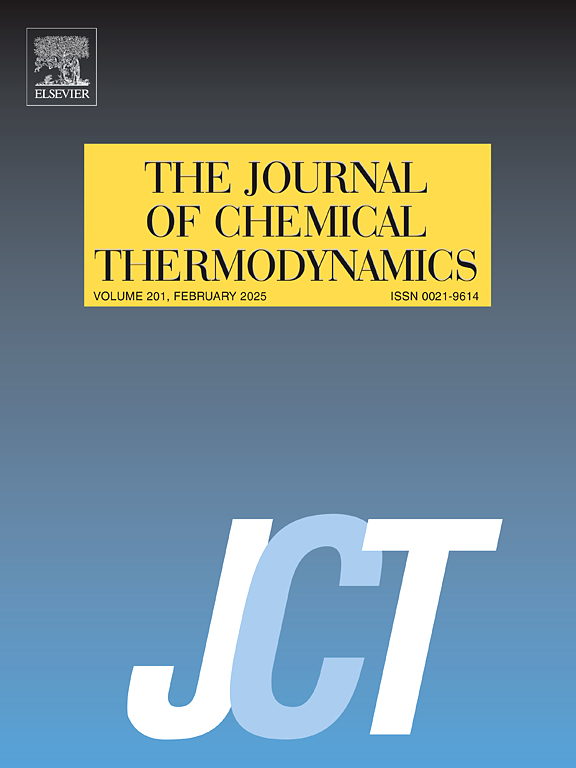羟基氟碳醚的热力学
IF 2.2
3区 工程技术
Q3 CHEMISTRY, PHYSICAL
引用次数: 0
摘要
矿物氟碳铈矿REECO3[F, OH] (REE = rare earth elements)是稀土元素的主要来源,可在加州帕斯山(Mountain Pass)和中国白云鄂博(Bayan Obo)等商业矿床中发现。此外,在光学器件、荧光粉、电池、陶瓷和磁体等方面,其天然和合成形式的应用已被探索,占世界稀土元素消费量的41%。因此,研究和分析稀土矿物的热力学性质对于了解稀土矿物的来源、改进提取工艺和优化工业应用至关重要。本研究对表征良好的合成羟基氟碳醚化合物LaCO3OH、PrCO3OH、NdCO3OH、SmCO3OH和EuCO3OH的结构和热力学性质进行了详细的重新评价。它们的标准生成焓(ΔH0f)由高温氧化物熔体溶液量热法测定,标准熵(S0)由1.8至300 K的低温热容(cp)测量得到,并结合爱因斯坦和德拜模型外推至600 K。这样就可以计算吉布斯生成能(ΔG0f)。通过与REE3+阳离子的离子半径和使用实验cp拟合的较高温度的关系来推断重稀土的热力学性质,为羟基碳酸盐提供了稳定性约束,允许对REE-H2O-CO2体系进行建模。本文章由计算机程序翻译,如有差异,请以英文原文为准。
Thermodynamics of hydroxylbastnaesite
The mineral bastnaesite, REECO3[F, OH] (REE = rare earth elements), is a major source of rare earth elements and can be found in commercial deposits such as Mountain Pass, California, and Bayan Obo, China. In addition, its natural and synthetic forms have been explored for applications in optical devices, phosphors, batteries, ceramics, and magnets, accounting for 41 % of the world's consumption of rare earth elements. Therefore, investigating and analyzing thermodynamic properties of REE minerals are crucial for understanding origin, improving extraction processes, and optimizing industrial applications. This study presents a detailed reevaluation of structural and thermodynamic properties of well-characterized synthetic hydroxyl bastnaesite compounds: LaCO3OH, PrCO3OH, NdCO3OH, SmCO3OH, and EuCO3OH. Their standard enthalpies of formation (ΔH0f) were determined by high temperature oxide melt solution calorimetry and standard entropy (S0) was obtained from low temperature heat capacity (cp) measurement from 1.8 to 300 K, extrapolated to 600 K combined the Einstein and Debye models. These allowed calculation of the Gibbs energy of formation (ΔG0f). Extrapolation of thermodynamic properties to the heavy REEs by relation to the ionic radius of the REE3+ cation and to higher temperatures using the experimental cp fit provides stability constraints for hydroxylcarbonates allowing for modelling REE-H2O-CO2 systems.
求助全文
通过发布文献求助,成功后即可免费获取论文全文。
去求助
来源期刊

Journal of Chemical Thermodynamics
工程技术-热力学
CiteScore
5.60
自引率
15.40%
发文量
199
审稿时长
79 days
期刊介绍:
The Journal of Chemical Thermodynamics exists primarily for dissemination of significant new knowledge in experimental equilibrium thermodynamics and transport properties of chemical systems. The defining attributes of The Journal are the quality and relevance of the papers published.
The Journal publishes work relating to gases, liquids, solids, polymers, mixtures, solutions and interfaces. Studies on systems with variability, such as biological or bio-based materials, gas hydrates, among others, will also be considered provided these are well characterized and reproducible where possible. Experimental methods should be described in sufficient detail to allow critical assessment of the accuracy claimed.
Authors are encouraged to provide physical or chemical interpretations of the results. Articles can contain modelling sections providing representations of data or molecular insights into the properties or transformations studied. Theoretical papers on chemical thermodynamics using molecular theory or modelling are also considered.
The Journal welcomes review articles in the field of chemical thermodynamics but prospective authors should first consult one of the Editors concerning the suitability of the proposed review.
Contributions of a routine nature or reporting on uncharacterised materials are not accepted.
 求助内容:
求助内容: 应助结果提醒方式:
应助结果提醒方式:


